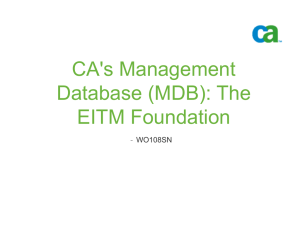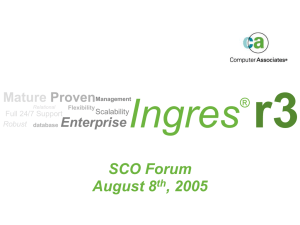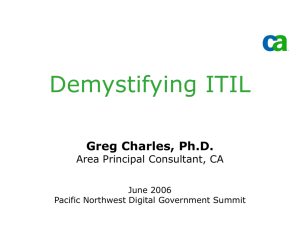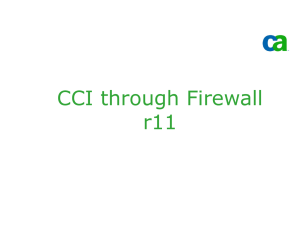The Role of State IT in Homeland Security
advertisement
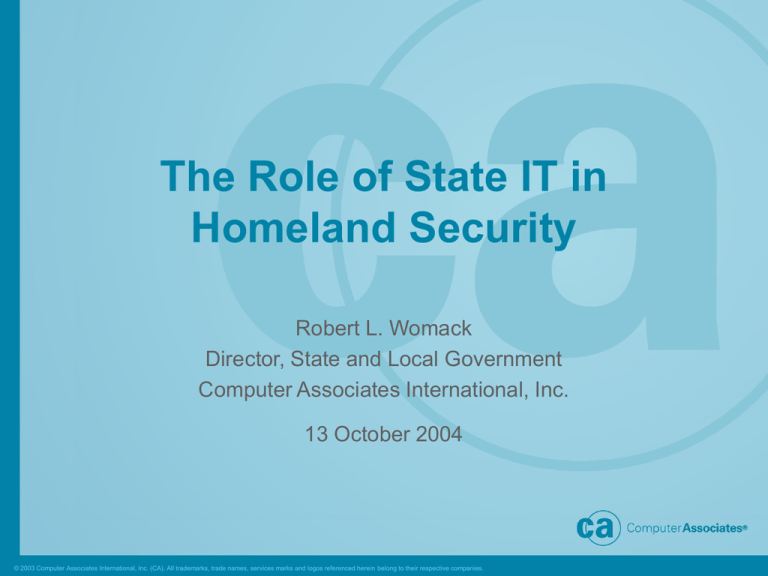
The Role of State IT in Homeland Security Robert L. Womack Director, State and Local Government Computer Associates International, Inc. 13 October 2004 © 2003 Computer Associates International, Inc. (CA). All trademarks, trade names, services marks and logos referenced herein belong to their respective companies. Outline Challenges Federal Guidance NASCIO Vision – a Homeland Security Dashboard Concerns implied by the NASCIO Vision Enterprise Concerns Intelligence Concerns Situational Awareness Concerns Next Steps © 2003 Computer Associates International, Inc. (CA). All trademarks, trade names, services marks and logos referenced herein belong to their respective companies. Today’s Challenges New Challenges seen since 9/11 Must assume that new attacks are possible and probable – need to build systems to “warn, detect, defend & restore” Attacks will be against: Information Systems People and Property All critical infrastructures are at risk and novel attacks are possible “Intelligence” and “knowledge” within each infrastructure are precious resources – need to leverage this resource Since 9/11, we have learned that a vast quantity of data has little or no value in its undigested form. © 2003 Computer Associates International, Inc. (CA). All trademarks, trade names, services marks and logos referenced herein belong to their respective companies. Today’s Challenges* But, great added value comes when the data from multiple sources is… collected in an organized way from vigilant and discerning sources in a timely and comprehensive manner, analyzed for short-term and long-term as well as localized and widespread implications, disseminated to appropriate recipients to alert potential targets, apprehend potential perpetrators, and inform incident managers in order to prevent attacks, reduce vulnerabilities to attacks, and expedite recovery from attacks. *This presentation is based on a line of reasoning first discussed in an as yet unpublished NASCIO white paper. NASCIO, “Using Information and Communications Technology to Support the State Homeland Security Mission” draft dated May 7, 2004. While this document has not yet been formally approved, we believe it makes a compelling case. © 2003 Computer Associates International, Inc. (CA). All trademarks, trade names, services marks and logos referenced herein belong to their respective companies. Today’s Challenges Using secure information and knowledge systems to protect our nation’s critical infrastructures Systems must leverage “human intelligence” Systems must become intelligent: Learn from all the data available Present information intuitively Be brilliant 24 x 7 x 365 Be secure Need to turn data into knowledge and action © 2003 Computer Associates International, Inc. (CA). All trademarks, trade names, services marks and logos referenced herein belong to their respective companies. Front Line Integrated Threat Analysis Support Tailored visualization of operational real-time and historical information that officers can act on Human support Defined rules, Intelligence and workflow to support information processing and knowledge management Secure, identity-& role-based, access control to Infrastructure indications & warnings support A secure, robust network & information infrastructure Crisis management support for emergencies and disaster recovery © 2003 Computer Associates International, Inc. (CA). All trademarks, trade names, services marks and logos referenced herein belong to their respective companies. Federal Guidance The National Strategy for the Physical Protection of Critical Infrastructures and Key Assets states: All U.S. states and territories have established homeland security liaison offices to manage their counter-terrorism and infrastructure protection efforts. Like the federal government, states should identify and secure the critical infrastructures and key assets under their control. States should promote the coordination of protective and emergency response activities and resource support among local jurisdictions and between regional partners States should further facilitate coordinated planning and preparedness by applying unified criteria for determining criticality, prioritizing protection investments, and exercising preparedness within their jurisdictions. They should also act as conduits for requests for federal assistance when the threat at hand exceeds the capabilities of state and local jurisdictions and the private entities within them. States should also facilitate the exchange of relevant security information and threat alerts down to the local level. © 2003 Computer Associates International, Inc. (CA). All trademarks, trade names, services marks and logos referenced herein belong to their respective companies. Federal Guidance “FY 2005 is a start up year for [National Incident Management System] NIMS implementation and full compliance with the NIMS is not required for you to receive FY 2005 grant funds. Since FY 2005 is a critical year for initial NIMS adoption, you should start now by prioritizing your FY 2005 preparedness assistance (in accordance with the eligibility and allowable uses of the grant) to facilitate its implementation.” “States, territories, tribes, and local entities are encouraged to achieve full NIMS implementation during FY 2005. To the extent that full implementation is not possible during FY 2005, Federal preparedness assistance must be leveraged to complete NIMS implementation by FY 2006. By FY 2007, Federal preparedness assistance will be conditioned by full compliance with the NIMS.” Secretary Tom Ridge Department of Homeland Security “Letter to Governors” dated 8 September 2004 © 2003 Computer Associates International, Inc. (CA). All trademarks, trade names, services marks and logos referenced herein belong to their respective companies. Draft NASCIO Vision The Homeland Security Dashboard Is the business of the state IT organization Is a decision support tool based on current information and communications technologies Forms the core of an integrated threat analysis center for the state’s homeland security team Is the primary source for “actionable intelligence” Leverages state IT investments to provide a common operating picture and “situational awareness” to both first responders and “first preventers” Will be encouraged by the National Incident Management System (NIMS) standards. © 2003 Computer Associates International, Inc. (CA). All trademarks, trade names, services marks and logos referenced herein belong to their respective companies. Concerns Implied by the NASCIO Vision Enterprise Concerns Intelligence Concerns Situational Awareness Concerns © 2003 Computer Associates International, Inc. (CA). All trademarks, trade names, services marks and logos referenced herein belong to their respective companies. Enterprise Concerns Use an existing enterprise advisory or governing board to assess the current and likely impact of homeland security information and communications technology (ICT) on the state enterprise. Tomorrow’s silos are being built today. Use an existing enterprise architecture (EA) advisory or governing board to assess the impact of homeland security decision support needs on the larger state EA program in order to support needs for flexible, secure, reliable, and appropriately handled homeland security information. Identity management must be at the heart of homeland security decision support systems. Does the current identity management strategy provide the necessary foundation for homeland security decision support? How must the current strategy be changed or extended? © 2003 Computer Associates International, Inc. (CA). All trademarks, trade names, services marks and logos referenced herein belong to their respective companies. Intelligence Concerns Download the Global Intelligence Working Group’s “National Criminal Intelligence Sharing Plan” at http://it.ojp.gov/topic.jsp?topic_id=93. Assess the impact of moving sensitive law enforcement, homeland security, and health care information across the statewide ICT infrastructure. Assess the implications for developing a statewide intelligence “fusion” center, information sharing and analysis program, or critical infrastructure protection (CIP) office where analysis of intelligence will be conducted and warnings/alerts produced. Be prepared to contribute intelligence regarding physical and “cyber”-based threats to state government’s critical information assets as part of the state’s larger intelligencegathering efforts. “Strobes” of IT systems supporting first responders may be a precursor to an attack. © 2003 Computer Associates International, Inc. (CA). All trademarks, trade names, services marks and logos referenced herein belong to their respective companies. Situational Awareness Concerns Download FEMA’s National Incident Management System (NIMS) plan at http://www.dhs.gov/dhspublic/display?content=3258. Watch for compliance guidelines to be issued in October 2004. Assess the impact of requirements for complying with NIMS. Pay close attention to chapter five “Communication and Information Management” and tab nine “Examples of ICS Forms,” which will likely lead XML-based standards development for interjurisdictional document exchange. © 2003 Computer Associates International, Inc. (CA). All trademarks, trade names, services marks and logos referenced herein belong to their respective companies. Actionable Intelligence Get the right information to the right person at the right time in the right way DoIT DHS IJIS IT Security Systems Information Sources Enterprise Resource Management Information Knowledge Information Delivery Information Gateway © 2003 Computer Associates International, Inc. (CA). All trademarks, trade names, services marks and logos referenced herein belong to their respective companies. Next Steps Participate in homeland security planning. Consider IT security as you deploy new applications. Remember that alerts from your IT security system(s) are valuable inputs to your state’s integrated threat analysis center. Assist your CISO community in making cyber security a part of your state/agency’s homeland security plan. If you support First Responders, begin NIMS planning this year. © 2003 Computer Associates International, Inc. (CA). All trademarks, trade names, services marks and logos referenced herein belong to their respective companies. Questions? © 2003 Computer Associates International, Inc. (CA). All trademarks, trade names, services marks and logos referenced herein belong to their respective companies. References © 2003 Computer Associates International, Inc. (CA). All trademarks, trade names, services marks and logos referenced herein belong to their respective companies. First Responder Grant Budget Trends DHS First Responder Funding 4.2 4.1 $ Billions 4 3.6 3.75 3.75 3.8 3.6 3.5 3.4 3.2 3 FY 2003 Final FY 2004 Final Fiscal Year Source: INPUT, 5 October 2004 © 2003 Computer Associates International, Inc. (CA). All trademarks, trade names, services marks and logos referenced herein belong to their respective companies. FY 2005 DHS / ODP Permitted Spending for Cyber Security Intrusion Detection Configuration Management and Patch Distribution Scanning and Detection Tools Geographic Information Systems Network Systems Management (NSM) and Analysis Encryption Systems Firewall and Authentication Security Hardware and Software for Counter measures © 2003 Computer Associates International, Inc. (CA). All trademarks, trade names, services marks and logos referenced herein belong to their respective companies. Security Control Center Data On Demand Integrated Security View Physical Security View Cyber-security View www transferred data (KBytes) Top 10 Active Clients Real Time – Or – Time Lapse Total security violations Entering Cyberspace Compile, Display & Analyze Security Events from Disparate Sources -- Fully Customizable for Group or Individual Needs © 2003 Computer Associates International, Inc. (CA). All trademarks, trade names, services marks and logos referenced herein belong to their respective companies. Physical Security View © 2003 Computer Associates International, Inc. (CA). All trademarks, trade names, services marks and logos referenced herein belong to their respective companies. CA Fast Facts Founded in 1976 Headquartered in Islandia, New York Fiscal Year 2004 revenues of $3.28 billion More than15,000 employees in more than 40 countries Committed to the highest corporate governance standards Executive Team Lewis Ranieri, Chairman Kenneth Cron, Interim Chief Executive Officer Jeff Clarke, Chief Operating Officer and Chief Financial Officer Kenneth Handal, Executive Vice President and General Counsel Mark Barrenechea, Executive Vice President of Product Development Greg Corgan, Executive Vice President of Worldwide Sales Yogesh Gupta, Chief Technology Officer © 2003 Computer Associates International, Inc. (CA). All trademarks, trade names, services marks and logos referenced herein belong to their respective companies. CA Leadership Credentials Shaping the industry through innovation Pioneered enterprise systems management software Awarded 280 patents for advanced technology solutions Active in every major standards organization First to earn the International Organization for Standardization’s (ISO) 9002:1994 Global Certification and 9001:2000, the new, ultimate ISO certification Only company to use one system to manage quality throughout its worldwide operations World’s leading businesses partner with us 95 percent of the Fortune 500® as well as thousands of other companies worldwide use our software Partnerships drive success Developed significant relationships with customers, industry peers and community organizations Organized channel operations to make it easier for customers of all sizes to purchase and use CA solutions © 2003 Computer Associates International, Inc. (CA). All trademarks, trade names, services marks and logos referenced herein belong to their respective companies. Contacts Contacts for more information: Erin Sullivan VP, State and Local Government – 908-531-0128 Rod Hovater Account Director – State and Local – 770-953-3640 Bob Womack Business Development Director – HLS – 617-733-5741 © 2003 Computer Associates International, Inc. (CA). All trademarks, trade names, services marks and logos referenced herein belong to their respective companies. The Role of State IT in Homeland Security Robert L. Womack Director, State and Local Government Computer Associates International, Inc. 13 October 2004 © 2003 Computer Associates International, Inc. (CA). All trademarks, trade names, services marks and logos referenced herein belong to their respective companies.

